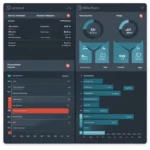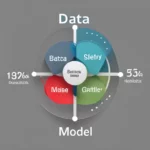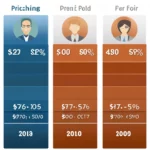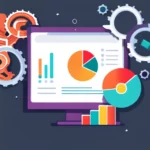Introduction
When it comes to data analysis and visualization, two of the most popular tools are Tableau and MS Power BI. Both offer powerful features and the ability to create stunning visuals, but which one is right for you? This blog post will explore the differences between Tableau and MS Power BI to help you make an informed decision. We’ll look at everything from pricing to compatibility to scalability, so you can decide which software best meets your needs.
Overview of MS Power BI and Tableau

When it comes to Business Intelligence tools, MS Power BI and Tableau are two of the biggest players in the market. MS Power BI, developed by Microsoft, is a cloud-based tool that allows users to easily analyze, visualize, and share data. On the other hand, Tableau, now part of Salesforce, is known for its powerful analytics and interactive dashboards.
Both MS Power BI and Tableau offer a range of features to help users make sense of their data. They provide intuitive interfaces, drag-and-drop functionality, and a wide variety of visualization options. However, there are some key differences between the two.
While MS Power BI is known for its ease of use and integration with other Microsoft products, Tableau offers more advanced data modeling and preparation capabilities. Additionally, Tableau has a stronger reputation for its data visualization capabilities, with users often praising its ability to create beautiful and interactive dashboards.
Ultimately, the choice between MS Power BI and Tableau depends on your specific needs and preferences. In the following sections, we will dive deeper into the various aspects of these tools to help you make an informed decision.

User interface comparison
When it comes to comparing the user interface of MS Power BI and Tableau, both tools excel in their own unique ways. MS Power BI offers a clean and intuitive interface that is designed to be user-friendly, making it accessible for users of all skill levels. The interface is similar to other Microsoft products, making it easy to navigate for those already familiar with the Microsoft ecosystem. On the other hand, Tableau takes a more visual and interactive approach with its user interface. Its drag-and-drop functionality allows users to easily create and modify visualizations, while its dashboard interface provides a seamless experience for exploring data. Both tools offer a wide range of customization options, allowing users to tailor the interface to their specific needs. Ultimately, the choice between MS Power BI and Tableau will depend on your personal preferences and the level of customization you require.
Data connectivity options comparison

Data connectivity is a crucial aspect to consider when choosing a Business Intelligence tool. Both MS Power BI and Tableau offer a wide range of options for connecting to different data sources. MS Power BI supports a vast array of connectors, allowing users to easily connect to popular databases, cloud services, and even Excel files. It also provides seamless integration with other Microsoft products, such as Azure and SQL Server. On the other hand, Tableau also offers a strong set of connectors, including support for various databases, cloud services, and web connectors. Tableau’s Data Interpreter feature allows users to clean and shape their data directly within the tool, which can be a great time-saver. In terms of data connectivity, both MS Power BI and Tableau provide powerful options that cater to different user needs. Whether you prefer the seamless integration with Microsoft products offered by MS Power BI or the advanced data shaping capabilities of Tableau, both tools ensure that you can easily connect to your desired data sources.

Visualization capabilities comparison
One of the key aspects to consider when choosing between MS Power BI and Tableau is their visualization capabilities. Both tools are known for their ability to create stunning visualizations, but they have some key differences in this area.
MS Power BI offers a wide range of visualization options, including bar charts, pie charts, line graphs, and maps. It also provides interactive features such as drill-downs, filters, and tooltips, which allow users to explore their data in more depth. MS Power BI also offers built-in AI capabilities, such as the ability to automatically generate insights and recommendations based on your data.
Tableau, on the other hand, is often praised for its powerful data visualization capabilities. It offers a vast array of chart types, including treemaps, heat maps, and scatter plots, allowing users to create highly customized visualizations. Tableau also provides advanced features such as storytelling, which allows users to create narratives with their data, and the ability to integrate with other visualization tools such as R and Python.
Ultimately, the choice between MS Power BI and Tableau in terms of visualization capabilities will depend on your specific needs and preferences. MS Power BI offers a user-friendly interface with a wide range of pre-built visualizations and interactive features, while Tableau provides more advanced customization options and integration capabilities with other visualization tools. Consider the types of visualizations you need to create and the level of customization you require when making your decision.
Data modeling and preparation features comparison

When it comes to data modeling and preparation, both MS Power BI and Tableau offer powerful features that can help users make sense of their data. Both tools provide a range of capabilities that can be leveraged to transform raw data into meaningful insights.
MS Power BI provides a user-friendly interface for data modeling and preparation. It offers features such as data shaping, merging, and cleaning that allow users to transform and prepare their data for analysis. MS Power BI also offers built-in AI capabilities that can assist users in automating certain aspects of data modeling and preparation.
Tableau, on the other hand, provides more advanced data modeling and preparation capabilities. It offers a robust set of features that allow users to manipulate, join, and blend data from multiple sources. Tableau also provides advanced data cleansing and transformation options, making it easier for users to prepare their data for analysis.
Ultimately, the choice between MS Power BI and Tableau in terms of data modeling and preparation features depends on the specific needs of the user. MS Power BI offers a user-friendly interface with AI capabilities, while Tableau provides more advanced data manipulation options. Users should consider their data preparation requirements and choose the tool that best meets their needs.

Pricing and licensing comparison
When it comes to comparing the pricing and licensing options of MS Power BI and Tableau, there are some key differences to consider. MS Power BI offers a range of pricing plans, including a free version with limited features, a Pro version for individual users, and a Premium version for larger organizations. The Pro version starts at $9.99 per user per month, while the Premium version starts at $4,995 per month for dedicated capacity. Tableau, on the other hand, offers three pricing plans: Tableau Creator, Tableau Explorer, and Tableau Viewer. These plans start at $70, $35, and $12 per user per month, respectively. It’s important to note that Tableau also offers a Desktop version for individual use, starting at $70 per user per month. When comparing pricing and licensing options, it’s essential to consider the specific needs of your organization, the number of users, and the desired features. Additionally, keep in mind any potential future scalability needs that may impact your decision.
Integration with other tools and platforms comparison

When it comes to integrating with other tools and platforms, both MS Power BI and Tableau offer powerful capabilities. As Business Intelligence tools, they understand the importance of connecting with other systems to access and analyze data from various sources.
MS Power BI integrates seamlessly with other Microsoft products, such as Excel, SharePoint, Azure, and SQL Server. This makes it easy to import data from these sources and combine them with your Power BI dashboards. Additionally, Power BI has robust API capabilities, allowing users to connect with third-party applications and services.
Tableau also provides extensive integration options. It can connect with various data sources, including databases, cloud services, and web connectors. Tableau also offers connectors for popular platforms like Salesforce, Google Analytics, and Amazon Redshift. Furthermore, Tableau has an extensive community of developers who have built additional connectors and integrations, providing users with even more options.
Both tools excel in integrating with other tools and platforms, providing users with flexibility and accessibility to their data. The choice between MS Power BI and Tableau in terms of integration capabilities will depend on your specific needs and the systems you use within your organization.

Customer support and community comparison
When it comes to customer support and community, both MS Power BI and Tableau have their own strengths. MS Power BI offers excellent customer support, with a comprehensive knowledge base, community forums, and official support channels. Microsoft also provides regular updates and releases new features based on user feedback, ensuring that customers are well-supported and their needs are addressed.
Tableau, on the other hand, has a vibrant and active user community. With a strong presence on social media platforms and dedicated user forums, Tableau users have access to a wealth of knowledge and resources. Tableau also hosts annual conferences and events where users can connect, learn, and share their experiences.
Both tools have a strong customer support system and an engaged user community. The choice between MS Power BI and Tableau in terms of customer support and community will ultimately depend on your personal preference and the type of support you value most. Whether you prefer direct support from Microsoft or the collective wisdom of the Tableau community, both tools ensure that you have access to the resources you need.
Pros and cons of MS Power BI

MS Power BI offers several benefits that make it a popular choice among users. One of the biggest advantages is its ease of use and user-friendly interface. The intuitive drag-and-drop functionality allows even beginners to quickly create insightful visualizations. Additionally, MS Power BI seamlessly integrates with other Microsoft products, such as Excel and SQL Server, making it convenient for users already familiar with the Microsoft ecosystem.
However, MS Power BI does have some limitations. The free version, while a great starting point, has limited features and data capacity. The Pro and Premium versions can be expensive for organizations with a large user base. Another drawback is that the advanced features and customization options in MS Power BI may not be as extensive as those offered by Tableau.
In summary, MS Power BI is an excellent choice for users who value simplicity, integration with Microsoft products, and a user-friendly interface. However, for users who require more advanced customization options and powerful analytics capabilities, Tableau may be a better fit.

Pros and cons of Tableau
Tableau offers a range of benefits that make it a popular choice among users. One of its key strengths is its powerful data visualization capabilities. Tableau allows users to create highly customized and interactive visualizations, offering a wide range of chart types and advanced features like storytelling. This makes it ideal for users who want to create visually stunning and engaging dashboards.
Additionally, Tableau provides advanced data modeling and preparation features. Its robust set of tools allows users to manipulate, join, and blend data from multiple sources, making it easier to transform raw data into meaningful insights.
However, Tableau does have some drawbacks. Compared to MS Power BI, Tableau can be more complex and may require a steeper learning curve. Additionally, Tableau’s pricing plans can be more expensive, especially for organizations with a large user base.
Overall, Tableau is a great choice for users who value advanced customization options and powerful analytics capabilities. However, users should be prepared to invest time in learning the tool and consider the cost implications before making a decision.
Whether you’re working with Tableau or MS Power BI, when you need to effortlessly extract metadata or generate comprehensive documentation for your dashboards in mere seconds, thereby conserving 8–10 hours per workbook, consider giving RapidDox a go.
Disclaimer: Above views and recommendations are purely my personal views in personal opinion. These opinions are not the perspectives of my current or previous employers.

